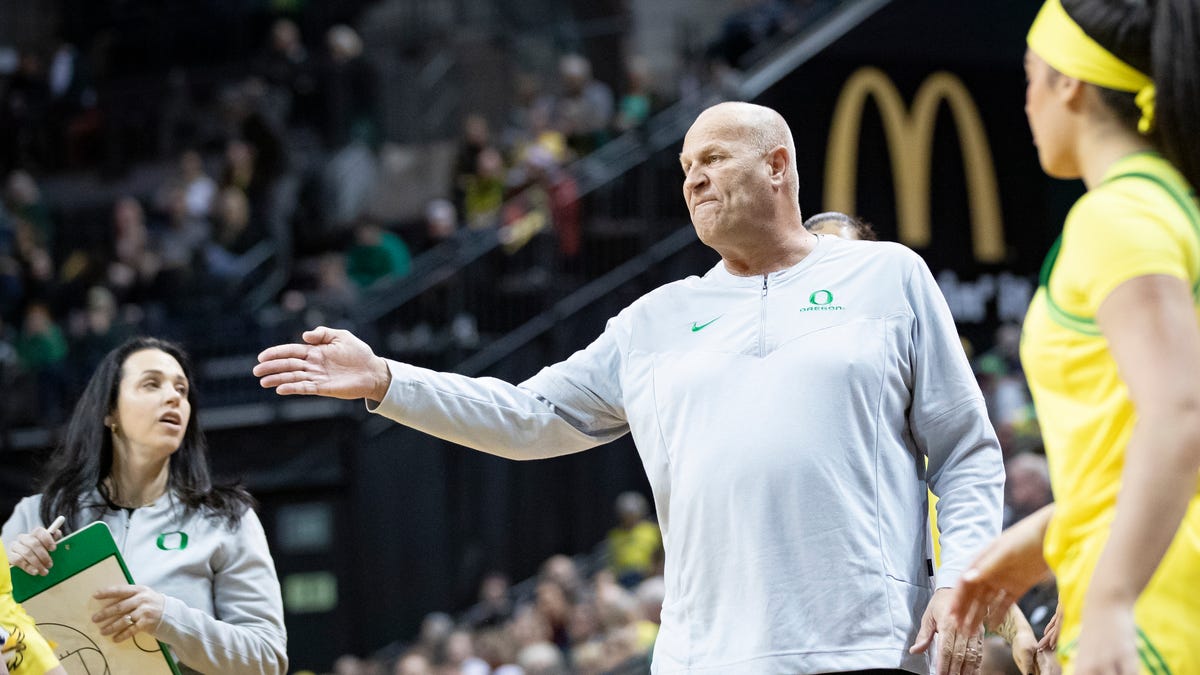Oregon
Oregon women’s basketball opponents and locations announced for first Big Ten season

The opponents and locations for the Oregon women’s basketball team’s upcoming 2024-25 schedule were revealed by the Big Ten Conference Tuesday.
In the Ducks’ first season as a Big Ten school they will host Indiana, Iowa, Maryland, Purdue, Rutgers, UCLA, USC, Wisconsin and Washington at Matthew Knight Arena.
Each team will play an 18-game conference schedule, playing one opponent home and away with 16 single-game opponents. Oregon plays Washington both at home and on the road.
The teams Oregon will play on the road are Illinois, Michigan, Michigan State, Minnesota, Nebraska, Northwestern, Ohio State and Penn State.
Dates and times have yet to be announced.
Alec Dietz covers University of Oregon football, volleyball, women’s basketball and baseball for The Register-Guard. You may reach him at adietz@registerguard.com and you can follow him on X @AlecDietz.

Oregon
Rare deep-sea fish washes up on Oregon beach
It always pays to keep one eye on the ocean and one eye on the sand when you’re walking along the beach at the Oregon Coast, a lesson reinforced by some Cannon Beach beachcombers who discovered a rare deep-sea angler fish known as a Pacific football fish (Himantoliphus sagamius) south of town.
In a press release, Seaside Aquarium said the fish, which used a phosphorescent bulb attached to its forehead to attract prey, is believed to be the first of its species to ever be found in Oregon. Only 31 other specimens have been recorded around the world, in places like New Zealand, Japan, Chile, Hawaii and California.
Pacific football fish live at depths of 2,000 to 3,300 feet in the Pacific Ocean. Because food is scarce at that depth where sunlight cannot reach, the fish has evolved to eat anything that it can lure into its mouth.
Not much is known about this species that lives in the very dark depths of the ocean, but according to the Seaside Aquarium, “Only females actively hunt as the males are actually more like parasites.”
The male fish are 10 times smaller than females and to survive, must fuse themselves to a female. There, they lose their eyes and internal organs, the aquarium said, and get all their nutrients from the female, while providing her with a dependable source of sperm.
– Lizzy Acker covers life and culture and writes the advice column Why Tho? Reach her at 503-221-8052, lacker@oregonian.com or @lizzzyacker
Our journalism needs your support. Subscribe today to OregonLive.com.
Oregon
Tired of your state politics? These residents are looking to secession as the solution.

An Oregon ballot initiative is the latest in a long line of secession efforts that speak to the nation’s sharp divide.
Can a state actually secede?
A growing number of Americans are in favor of a national divorce. What’s the likelihood of secession by states like Texas or California?
Straight Arrow News
PRINEVILLE, Oregon ‒ Tens of thousands of rural, conservative eastern Oregon residents are so frustrated with their liberal urban neighbors they’ve decided they can no longer even share a ZIP code.
The “Greater Idaho Movement” would shift the Oregon border 200 miles west, a secession effort aligning the conservative farming, ranching and logging communities of eastern Oregon with their like-minded neighbors to the east. A dozen counties in eastern Oregon have already approved the plan, and voters in Crook County and the county seat of Prineville are currently considering the non-binding measure with results due Tuesday.
“I love Oregon but I just don’t love the people running it right now,” said Eric Smith, 48, who owns two retail shops on Prineville’s main street. “It doesn’t feel like they want to keep us anyway.”
Across Crook County, pop. 26,325, even voters who oppose the measure say they’re tired of the dictates from liberal lawmakers in the state capital of Salem and the state’s population center of Portland, citing marijuana legalization, efforts to reduce fossil fuel use, gun-control measures and how the state handled the coronavirus pandemic.
The sentiment in eastern Oregon reflects a broader national frustration and divide over the direction of the country that’s playing out in school districts, university campuses and big cities, all the way up to Congress.
A 2023 study by a Colby College professor found that more than 25% of Americans support some sort of secession by states, and nearly 25% percent agreed it “makes sense to split the country up.”
Georgia Rep. Marjorie Taylor Greene, a Republican, highlighted the division many Americans feel when she tweeted in February 2023 that “we need a national divorce. We need to separate by red states and blue states and shrink the federal government…”
Ryan D. Griffiths, a political science professor at Syracuse University, said the Oregon ballot initiative is the latest in a long line of efforts, though most have never amounted to more than slogans and bumper stickers. Among them: the failed “State of Jefferson” proposal in Northern California, simmering secession movements in Vermont and Texas, and a short-lived effort to move a chunk of Northern Colorado into Wyoming.
Griffiths said like other secession efforts, the Greater Idaho Movement lacks a significant groundswell of public support, and in most cases is more of a referendum on state-level governance.
“It’s a pipe dream, in a way. What they’re doing is partly performative, for ideological purposes,” he said. “A lot of time, secessionist movements are really just bargaining efforts.”
Griffiths said scholars who study secession efforts, like those of the former U.S.S.R., see U.S.-based movements as “pretty lightweight stuff.” But he also acknowledged secession efforts like Greater Idaho keep bubbling up.
“It’s gaining a weird creeping momentum,” he said of proposed partisan divorces.
“If you imagine a full-blown project to divide America into red and blue states, that would be incredibly dangerous because you’d have to partition people off,” he said. “You don’t actually have neatly sorted populations, despite what many people think.”
Should neighbors share the same values?
In Oregon, the measure’s backers say they’re using a peaceful, existing political process to reduce friction between people at opposite ends of the political spectrum who are already living separate lives within the state. Supporters say they don’t want to just sell their homes and move to another state because they like living where they are.
“People have already sorted themselves into like-minded communities,” said Matt McCaw, a Greater Idaho movement spokesman. “People like to live around people who share the same values they do.”
Smith, the shop owner, used to live in nearby Bend, part of the far more liberal Deschutes County, but left in frustration over its political direction.
In the 2020 presidential election, Deschutes County voted 52% for Joe Biden, while Crook County, where he now lives, gave Trump 73% of its vote. The measure’s backers say they likely won’t seek support from Deschutes voters, even though the county is considered part of eastern Oregon.
Smith said he’s not sure how he’ll vote on secession, but he understands why people support it.
“Quit treating us like Portland,” he said, echoing the sentiment of many Crook County residents.
Experts say the kind of self-segregation decisions people like Smith make are reflected in recent migrations nationally to states like Texas and Florida, but also in the “white flight” movement of the 1950s and 1960s, as white city-dwellers moved to the suburbs.
The Greater Idaho movement would need approval from both Oregon and Idaho’s legislatures, along with Congress. Also undetermined would be how the Native American reservations in Eastern Oregon would be incorporated, as they span county and state borders.
McCaw, a foster parent who lives north of Prineville, said he doesn’t want to be forced to accept that there are more than two genders, or that people can change genders, and is frustrated by liberals who reject the role of the Christian church in daily life.
He said he and many of his neighbors are also still upset by how Oregon required businesses and churches to close during the coronavirus pandemic, compared to the looser restrictions in Idaho.
“We were forced into things we didn’t want and it was all done under the threat of punishment from the western part of state,” he said. “That opened a lot of people’s eyes. It’s one thing to see the legislature pass policies you don’t agree with, and another to have your business closed, couldn’t go to church.”
Workers and owners shop in the same stores
Above all, Crook County residents say, is the idea they know their neighbors, from the farmers and ranchers to the tech support workers at the massive Facebook and Apple data centers, and the ladies behind the counter at the Sandwich Factory.
Prineville shop worker Amanda Halcom, 30, said she’s still unsure how she’ll vote. She said the cost of housing is going up, and she worries drug abuse is increasing. She said she believes many of the laws passed by Oregon’s legislature will ultimately make Crook County more urban.
She said knowing her neighbors, taking personal responsibility for her actions and solving local problems locally are important values.
“We are supposed to be a small town. That’s whole point,” said Halcom, who worries about raising her kids in what she considers an increasingly liberal environment. “That’s the kind of stuff we move here for.”
One concern: what would happen to Halcom’s pay if eastern Oregon joined Idaho. While minimum wage in Crook County is $13.20 per hour, it’s $7.25 an hour in Idaho.
The nearest Walmart to Prineville is 30 miles away, and political concerns are usually more focused on whether a new dollar store fits into the community, and if nonprofit cleanup groups should get free access to the county dump.
Generally, Crook County has more in common with Idaho than most of its own state: The county is overall less racially diverse than both Oregon as a whole and the entire United States, and people living there earn less money than Oregon’s average. Crook County’s median family income is about $75,000, while it’s about $70,000 in Idaho and almost $87,000 for Oregon statewide.
“The mill owner and the mill worker have to go to the same restaurant, shop at the same grocery store. That keeps things in check,” said Seth Crawford, a Crook County commissioner.
Crawford hasn’t taken a formal position on the proposal, but he understands why many of his neighbors support it. He said he shares their concerns with how things are decided by “The Valley” ‒ the western Willamette Valley that’s home to 70% of the state’s population in Portland, Eugene and Salem.
Crawford has knocked on hundreds of his neighbors’ doors during his election campaigns and said he regularly hears the same concerns, from statewide marijuana legalization that Crook County opposed to complaints about how legislators want to regulate guns. People are also frustrated about paying higher taxes to fund government services they oppose, and want the freedom to raise their families as they see fit.
And while he said he still believes Crook County can make its voice heard at the statehouse, he understands why his neighbors might be willing to take the drastic step of secession.
“They want to be able to send a message to Salem: We’re not happy with the situation we’re in,” Crawford said.
People are tired of arguing
Competing signs across Prineville call to “Move Oregon’s Border” or urge voters to reject the effort with an “IdaNo!”
Secession supporter Josh Derrick, 44, said he thinks things go further than disagreements over how to live. He said fundamental lifestyle differences indicate a lack of common ground.
Derrick sells RVs, mostly the kind that require a large pickup to tow. But he keeps smaller ones on hand too, to sell to SUV-driving liberals who won’t buy trucks.
“People are just tired of arguing,” he said. “I want to work, make money, play with my toys and go fishing.”
Derrick said he never used to pay much attention to local politics, but got involved as the Greater Idaho movement came to his attention.
“I love Oregon. The chances of (the initiative) going through are pretty slim. But it’s getting a lot more people involved in politics,” he said. “If this gets more people involved, I count that as a win.”
Besides, he laughed, “I don’t hate liberals. I still need their money.”
McCaw, the initiative spokesman, said even if the Crook County vote fails, the Greater Idaho Movement will persist.
He said he believes Americans are just too divided, and that while people who disagree can live side-by-side, Oregon’s liberal politicians consistently force their values onto rural areas. He said if other states decide to follow suit, so be it ‒ there’s a process for changing boundaries for this exact reason.
“I don’t think we can sustain the path we are on,” McCaw said said. “We need to be OK saying your values are yours, mine are mine, and you have to respect our ability to have different views.”
Smith, the shop owner, said he might vote against the initiative because he favors keeping Oregon whole. Munching on a McDonald’s hash brown, Smith said he opened two shops because he’s confident Prineville and Crook County are good places to be.
He just wishes, he said, that politicians in Salem would listen to eastern Oregon’s concerns so that this talk of secession would die down.
Smith said he appreciates that Oregon has a wide diversity of thought and lifestyles, geography and employment: “That’s what made Oregon, Oregon. And I don’t want to let that go.”
Oregon
Stillman Valley ends Oregon’s season 2-1 at sectional
:quality(70):focal(1235x1175:1245x1185)/cloudfront-us-east-1.images.arcpublishing.com/shawmedia/B7OEBXHQ75HJXOZIR6TGOOXRVY.jpg)
WATERMAN – The season came to an end for the Oregon girls soccer team with a 2-1 loss to Stillman Valley in the Indian Creek 1A sectional semifinal on Saturday.
Coming in with an 18-1 record and 4-1 win over the Cardinals (18-4) during the regular season, the loss was stinging to coach Seger Larson.
“We were the better team, but they wanted it more,” said Larson. “We had way more chances (shots on goal).”
After a scoreless first half, Stillman Valley stunned the Hawks with goals at 6 and 22 minutes into the second half for a 2-0 lead.
“Our defense wasn’t ready,” Larson said.
The first score was by Harleigh Wallin, with an assist from Grace Costello. It appeared Wallin was planning a pass, but opted for a long shot and got it past goalie Mili Zaval.
“I think it surprised their goalie,” SV coach Erin McMaster said.
On the second score, it was Costello taking control of a possession at midfield and dribbling toward the goal. That set somewhat of a fluke goal in motion, as Amelia Dunseth took a shot at the goal and it grazed the hip of Emelia Winstead for the 2-0 lead.
Technically, the score was credited to Winstead. Still, it would have gone in the net had it not hit Winstead.
“Once we got a 2-0 lead, that really put the pressure on Oregon,” McMaster said.
Anna Stender gave Oregon life with a goal with 14 minutes left in the game, off a Sarah Eckardt assist. That play energized the Hawk crowd and team and Larson could be heard saying, “We’re still in this.”
With 2:30 left, the ball got loose near the SV net, but no one from Oregon could get a shot off before Sada Hughes grabbed it. Eckardt had a dead-on shot from the wing with a minute left, but it was Hughes covering it up.
“Our goalie was so focused,” McMaster said. She had improved tremendously.”
When SV previously lost to Oregon, it was foreign-exchange student Deb Schmid that did most of the damage. This time, McMaster had a plan to keep Oregon’s leading scorer in check.
“She really took it to us and we weren’t ready,” McMaster said. “We made sure to stay with her today.”
A major disappointment for Larson was a slow start by the Hawks.
“They wanted to control balls more than we did,” Larson said. “We weren’t anticipating balls or getting ahead on passes. We needed to be more aggressive in the first half.”
Towards the end of the first half, Stender had a breakaway, but Cynthia Estrada-Rodriguez defended her. Estrada-Rodriguez was SV’s last line of defense before the goalie and was on top of Oregon players every time they got near.
“She’s our best defender,” McMaster said. “She’s smart, quick and can play the angles.”
With 2 minutes left in the first half, Stender had Oregon best chance of the game thus far, but was denied by the stingy Cardinal defense.
Midway through the second half and trialing 1-0, Oregon’s Teagan Champley had an open shot on goal, but Hughes positioned herself directly in the pass of the ball for the save. Kenna Wubbena also had a shot glance off the crossbar.
“We never were able to get our game plan executed,” Larson said.
Rock Island Alleman beat Byron 4-1 in the other semifinal.
-

 Politics1 week ago
Politics1 week agoFox News Politics: No calm after the Stormy
-

 World1 week ago
World1 week agoIndia Lok Sabha election 2024 Phase 4: Who votes and what’s at stake?
-

 News1 week ago
News1 week agoSkeletal remains found almost 40 years ago identified as woman who disappeared in 1968
-

 Politics1 week ago
Politics1 week agoUS Border Patrol agents come under fire in 'use of force' while working southern border
-

 Politics1 week ago
Politics1 week agoTales from the trail: The blue states Trump eyes to turn red in November
-

 World1 week ago
World1 week agoBorrell: Spain, Ireland and others could recognise Palestine on 21 May
-

 World1 week ago
World1 week agoCatalans vote in crucial regional election for the separatist movement
-

 World1 week ago
World1 week agoEurope matters to consumers, and so does your vote

















